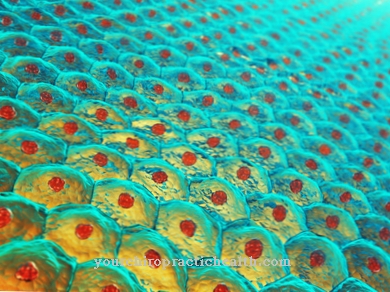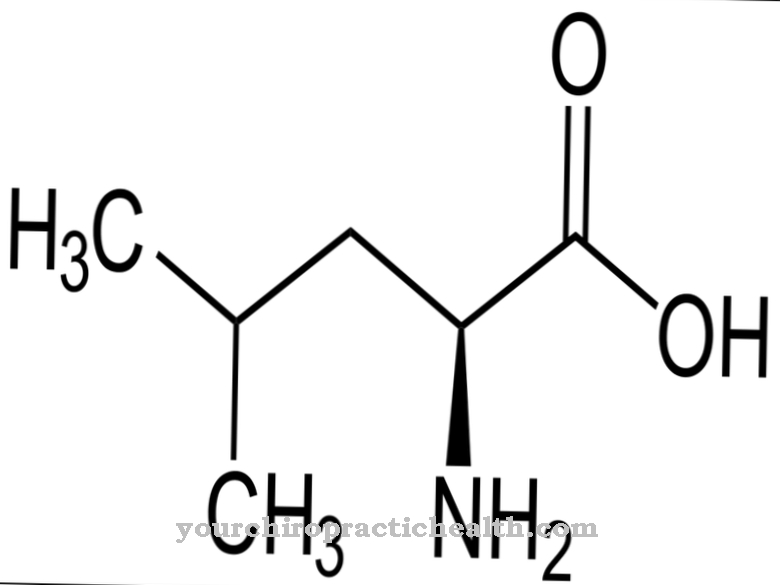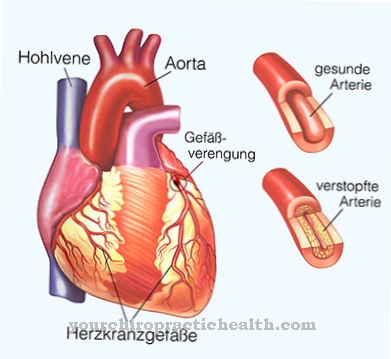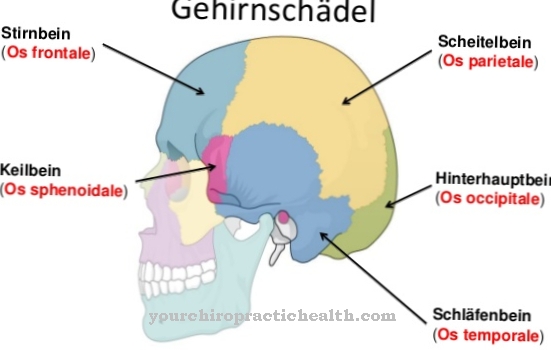Almost every second German suffers from one Enlargement of the thyroid gland, the relatively inconspicuous butterfly-shaped organ above the windpipe. Here are the reasons for a Goiter or Goiter diverse and sometimes even avoidable.
What is goiter (goiter)?
.jpg)
As Goiter - or Latin Goiter - one calls them Enlargement of the thyroid gland. Depending on the degree of enlargement, goiter is divided into three categories:
At Grade 0 the enlargement of the thyroid can only be determined by ultrasound.
Grade I. means that the thyroid is palpably enlarged.
The classification in Grade II indicates that the enlargement of the thyroid gland can not only be felt, but the goiter can also be clearly seen.
Often one can Goiter also arise without a disruption in thyroid hormone production. This is the most common case, then one speaks of a euthyroid goiter. In rarer cases, the thyroid either produces more hormones, known as hyperthyroid goiter, or produces too few hormones, leading to hypothyroid goiter.
The goiter can enlarge uniformly (goiter diffusa) or form lumps in places (goiter nodosa), which results in an irregular deformation of the thyroid gland. Depending on whether one or more nodes have formed, a distinction is made between the terms Struma uninodosa and Struma multinodosa.
causes
The causes of a Enlargement of the thyroid gland (goiter) can be very different. However, 90 percent of the cases are due to a diet-related iodine deficiency.
Other reasons for goiter formation can be autoimmune diseases such as Graves' disease, Hashimoto's thyroiditis, or goiter-like substances such as lithium, nitrates or thyreostatic agents that promote goiter.
Cysts or tumors can also cause goiter. In a few cases, other organs and tissues are also affected by metastases. Much rarer causes of goiter are benign pituitary gland tumors, but also disorders of thyroid hormone synthesis and diseases such as sarcoid or amyloidosis. Smoking and a selenium deficiency are also suspected of promoting goiter.
Symptoms, ailments & signs
A goiter can remain symptom-free for a long time. Some patients experience slight problems swallowing or have a lump in their throat. As the disease progresses, symptoms such as hoarseness, difficulty swallowing and shortness of breath appear. This can be accompanied by a feeling of tightness in the chest.
If there is an accompanying thyroid dysfunction, further symptoms can arise. These include, for example, gastrointestinal complaints and hormonal disorders. Externally, a goiter can often be recognized by the visible thickening of the neck. In some patients, hot lumps form in the thyroid area.
Then there may be hormonal complaints, pain and an increase in the original feeling of pressure. In the long term, these growths lead to an overactive thyroid, which is associated with further complications. The symptoms of a goiter develop insidiously. It often takes years before the goiter is noticed.
Then, however, permanent damage to the thyroid gland has usually already developed. If goiter is detected early, surgery can alleviate the symptoms. However, there is a risk that a goiter will develop again. A fully grown goiter restricts the quality of life of those affected considerably and in individual cases can also cause emotional complaints.
Diagnosis & course of disease
_2.jpg)
The course of thyroid diseases is often quite inconspicuous. For now it caused a diet-related Goiter no complaints whatsoever. Only the visible goiter with shortness of breath with increased stress or the kinking of the head as well as a feeling of pressure when swallowing suggest an illness.
Larger goiters can form so-called "goiter hearts", that is, the goiter develops in the direction of the breastbone and thus ensures a noticeable narrowing of the windpipe. The consequences are wheezing, shortness of breath and hoarseness.
Other clinical pictures arise from the formation of knots. Most thyroid nodules are benign in nature. However, a distinction is made between cold and hot nodules: While hot nodules are practically never malignant, isolated cold nodules often turn out to be thyroid carcinomas with a good iodine supply.
Complications
Goiter caused by iodine deficiency does not cause any noticeable complications. With larger goiter, the pressure on the trachea and esophagus can cause swallowing difficulties, shortness of breath and an uncomfortable feeling of pressure and lumpiness. If the goiter continues to expand, the windpipe narrows and the shortness of breath increases.
Due to the shortage of breath and the pressure on the blood vessels, the right heart is also stressed - a goiter heart forms. A goiter can cause nodules in the thyroid gland which, in the worst case, become inflamed and lead to sepsis. Surgical removal of a goiter can also result in complications. This can lead to bleeding, wound healing disorders and infections of the surgical area.
Visible scars can also develop. If important nerves are damaged, hoarseness and shortness of breath can occur, and the patient may need artificial ventilation. Thyroid surgery can also impair the function of the parathyroid glands. This throws the calcium level out of balance and leads to various complications. Finally, prescribed painkillers and narcotics can cause side effects and interactions or trigger allergic reactions in the patient.
When should you go to the doctor?
If the person concerned notices slight swellings or changes in the neck, these should be observed further. If the irregularity is temporary, in many cases a doctor is not required. This often leads to spontaneous healing due to an overload situation. If the growths or changes in the complexion persist, recur or increase in size, a doctor should be consulted. In the case of hormonal irregularities, abnormalities in the sensation of sexual pleasure or menstrual disorders, further examinations are necessary.
If the person concerned suffers from swallowing problems, changes in the vocal environment or shortness of breath, a doctor must be consulted. Hoarseness, a change in the color of the voice, or background noise while speaking should be investigated. Discoloration, redness, peculiarities of behavior or irritation are also signs of a health impairment. The symptoms must be presented to a doctor so that further investigations can be initiated. This is the only way to make a diagnosis, on the basis of which a treatment plan is drawn up.
Changes in hair growth as well as deformation of the nails or soft nails are also indications that can indicate irregularities in thyroid function. A doctor should also be consulted if there is a feeling of pressure on the neck, a decrease in well-being or increased tiredness. Mood swings, depressive states or an incomprehensible euphoric appearance should be investigated
Treatment & Therapy
For treating a Goiter there are three options. For example, if a thyroid enlargement is to be inhibited or reduced, drug therapy is possible. The thyroid volume can be reduced by administering levothyroxine or iodine, or a combination therapy in which the advantages of both active ingredients are used.
In the case of thyroid autonomy or diseases such as cancer or Graves disease, radioiodine therapy is used. This nuclear medicine procedure uses radioactive iodine to treat goiter, which is enriched in the thyroid gland and destroys excess hormone-producing tissue there. A combination of both treatment options is often used in the 1 to 3 year therapy.
If the quality of life is severely impaired by a goiter or a suspected thyroid carcinoma, surgery is the most effective treatment method. The entire thyroid gland, or that part of the goiter that produces too many hormones, is cut away. The operation is therefore also a quick therapy for the treatment of hyperfunction, since the remaining hormones in the blood are quickly broken down by the organism.
prevention
A prevention of Goiter can be guaranteed primarily through a basic iodine supply.In many countries, table salt in particular was fortified with iodine for this purpose, which has already resulted in a significant decrease in goiter formation, especially in children and adolescents.
You can do that yourself
A goiter must be treated with drugs or surgery. The most important self-help measure is the regular intake of the prescribed iodine preparations. Depending on the size of the goiter, intravenous iodine treatment is necessary. Chronically ill goiter patients have to take special iodine with L-thyroxine. In addition, the patient must take thyroid hormones. This will bring the thyroid back to its original size.
A healthy diet is a basic requirement for avoiding a goiter. Patients who repeatedly suffer from goiter should regulate the iodine in their diet so that the medical iodine dose can be precisely coordinated.
After surgery on the thyroid gland, the patient needs to rest. The surgical wound should heal quickly, as long as the patient does not strain it with strenuous physical activity. If symptoms reappear after the goiter has been removed, the doctor must be informed. Occasionally, after a goiter has been removed, there is a lack of calcium in the body. This can be counteracted by consuming foods that are high in calcium. In addition to dairy products, red meats as well as beans, nuts, herbs and green vegetables are available as calcium suppliers.








.jpg)



















